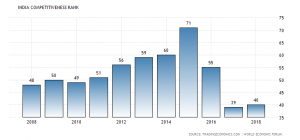The Global Competitiveness Index (GCI) is a comprehensive guide for policy makers and industry leaders to add to a roadmap to the digital economy. The World Economic Forum has enlarged the traditional definition of national competitiveness to emphasize the importance of social, cultural and economic factors, in addition to traditional measures of labour and capital productivity. Globally, the income inequality is rising, social and political tensions mounting, and there is a general feeling of uncertainty about the future. This is compositely resulting into low growth because of which both trade and commodity prices have fallen.
The Global Competitiveness Report began as a research project by Professor Klaus Schwab. He is a German engineer and economist, best known as the founder and executive chairman of the World Economic Forum. In 1979 he designed a report to measure and analyse competitiveness of 16 European countries. The study was based on Schwab’s innovative concept of competitiveness, which extended beyond the traditional notion of labor and capital productivity. That year, of the 200 indicators selected for the Forum’s first competitiveness index, 50 were derived from a survey.
The survey was mailed out in English, French, and German to potential respondents throughout Europe, mainly Chief Executive or Chief Planning Officers of European companies; Managing Directors of subsidiaries of US companies operating in these 16 countries, leading representatives of industrial and employers’ associations, labor unions, eco nomic and social institutes; university faculties of economics or business administration; and the economic media. Median values were calculated for each question and by country. In parallel, Forum researchers visited statistical offices and ministries in order to gather relevant quantitative data. The report was finalized in November 1979. The report was the first attempt to support policymakers and business leaders in their efforts to formulate improved economic policies and institutional reforms.
nomic and social institutes; university faculties of economics or business administration; and the economic media. Median values were calculated for each question and by country. In parallel, Forum researchers visited statistical offices and ministries in order to gather relevant quantitative data. The report was finalized in November 1979. The report was the first attempt to support policymakers and business leaders in their efforts to formulate improved economic policies and institutional reforms.
Thirty five years down, in 2004, WEF (World Economic Forum) started regular practice of ranking the economies to reignite economic growth. The Global Competitiveness Report is a tool to help governments, the private sector and civil society work together to boost future prosperity. Comparative analysis between countries allows leaders to measure areas that need strengthening and build a coordinated response. It also helps identify best practice in various nations in the world. The Index measures how productively a country uses available resources.
At present the Global Competitiveness Report has grown to cover over 140 economies to assess the key drivers of development. The methodology behind the analysis has been improved over the years in order to reflect the newest thinking in matters of economic growth. In parallel to this development of the index, the original survey has evolved and is today known as the Executive Opinion Survey (the Survey). Over the years, it has undergone a number of revisions and audits, which have enabled an improved administration process and methodology. The Survey has grown in scope, too. It now includes over 140 questions distributed in 14 sections.
The 12 pillars of competitiveness are grouped under three sub-indexes according to three main development phases: basic requirements, efficiency enhancers and innovation and sophistication factors. Depending on each country’s stage of development, weightage is added to the sub-indexes. Here are the 12 pillars of competitiveness that WEF uses to rank nations according to productivity and prosperity.
Pillar one is Institutions: The way institutions are managed, has a direct link to a nation’s level of competence. Efficient management of both private and government institutions is the basis of business environment. Good business practices combined with ethics and corporate governance guarantee success. Physical security and independent judiciary provide the fundamental protection of intellectual property rights (IPR).
Pillar two is Infrastructure: Infrastructure includes connectivity like road, rail, ports, electricity and telecommunications. These are fundamental to economic development and growth. Because of connectivity an economy opens to outside world, trade and commerce will flourish. Quality and quantity of infrastructure decides a nation’s level of productivity.
Pillar three is Macroeconomic Environment: Macroeconomic stabilization is a condition in which a complex framework for monetary and fiscal institutions and policies is established to reduce volatility and encourage welfare-enhancing growth. Inflation, price levels, rate of growth, national income, gross domestic product and changes in unemployment are some vital macroeconomic indicators of a nation.
Pillar four is Health and Primary Education: Education is fundamental to development and growth. The human mind can achieve advancements in healthcare, agricultural innovations to efficient public administration and private sector growth. Education helps to unleash progress of human. Health of people also makes an important contribution to economic progress; healthy populations live longer, are more productive, and save more. Clean environment, peace of mind, non corrupt government administration is some factors to provide good health for its people.
Pillar five is Higher Education and Training: High education and technical skills are crucial for the growth of an economy. Progressive nations therefore invest more in higher education and skill development. Higher educational facilities and on-the-job training can only assure growth as a nation moves up the ladder. Human capacity development is enhanced through quality education at many levels, including primary, secondary, technical and vocational, and higher education. As the world is growing more complex, higher education is an increasingly more critical pillar for human capacity development.
Pillar six is Goods Market Efficiency: A successful economy has to market its products and services worldwide. Growth depends on open markets and liberal marketing policies. Domestic and foreign competitiveness demands good marketing efficiency. It ensures the planned economic growth in the developing economy where the scarcity of goods, services, ideas and excessive unemployment, thereby marketing efforts are needed for mobilization of economic resources for additional production of ideas, goods and services resulting in greater employment.
Pillar seven is Labour Market Efficiency: Productivity depends on the quality of labour. Trained, organized and sincere workers are extremely important for organizational growth. A nation with a large scale of unemployment will never progress. The business environment has to assure promotion and development to the workers. Nations which promote gender parity have grown faster. Job market needs to be efficient and flexible. Skilled labour is always in demand.
Pillar eight is Financial Market Development: The financial system comprises all financial markets, instruments and institutions. The financial system is particularly important in reallocating capital and thus providing the basis for the continuous restructuring of the economy that is needed to support growth. In countries with a highly developed financial system, we observe that, a greater share of investment is allocated to relatively fast growing sectors. The banking system has to support business by channelling the resources saved by its people. Efficiency, stability, reliability and credibility of the financial system are crucial for the economy. Transparency and efficiency help in financial market development.
Pillar nine is Technological Readiness: Technology transfer and development is vital to the process of transforming economies to enable inclusive growth within the framework of sustainable development and poverty eradication. The definition of technology readiness is the set of capacities to plan for, catalyse, sustain, and monitor and report on technology transfer and development in ways that are fully integrated with national development priorities. In today’s world, technological readiness can only ensure quality and quantity of production and service.
Pillar ten is Market Size: Large markets without entry barriers allow faster growth. Both domestic and foreign markets are considered for the market size. Market sizing gives the business a sense of market trends. It gives clue on the necessary drivers of demand, as market movements often continue in one direction or another for a period of time. What’s more, those trends often indicate whether substitutions are available and whether that could potentially affect market size.
Pillar eleven is Business Sophistication: The eleventh pillar of GCI is sophistication in business practices that improve efficiency of production of goods and services. Sophistication is a key factor for innovation-driven economy and concerns the quality of a country’s overall business networks, as well as the quality of operations and strategy of individual firms. This pillar indicates local supplier’s quantity and quality, business cluster development, nature of competitive advantage, value chain width, control of international distribution etc.
Pillar twelve is Innovation: High competitiveness needs technological innovation. Advanced countries invest more in developing technologies. But other nations too can improve their productivity by making incremental improvements. Fundamentally, there are only two ways of increasing the output of the economy: (1) increase the number of inputs that go into the productive process, or (2) think of new ways in which you can get more output from the same number of inputs. Innovation drives the economic growth faster in people management, money management, processes management, materials management practically every aspect off business.
India’s ranking:
The most recent 2017-2018 edition of Global Competitiveness Report assesses 137 economies. This graph provides the latest reported value for – India Competitiveness Rank – plus previous releases, historical high and low, short-term forecast and long-term prediction, economic calendar, survey consensus and news. The actual data, historical chart and calendar of releases were last updated in May 2018.
Globally, Switzerland ranks at top for past six years. In 2018 at number two stands United States, at third position Netherlands, fourth Germany and fifth United Kingdom.
India has a long way to go.
















































